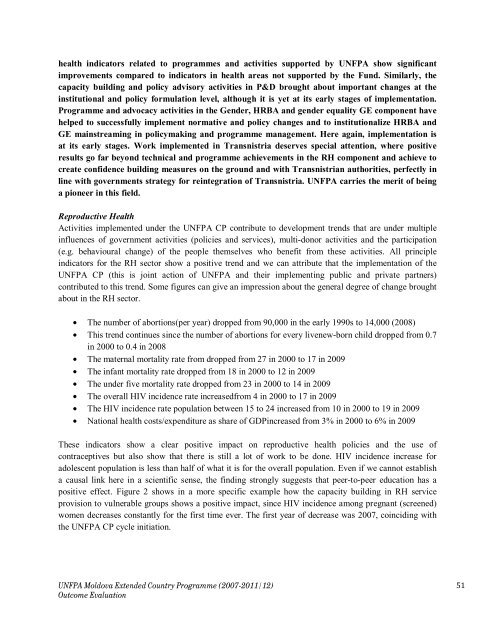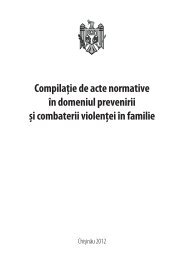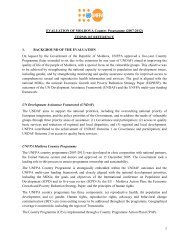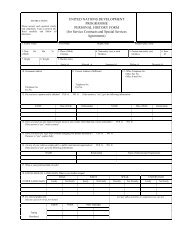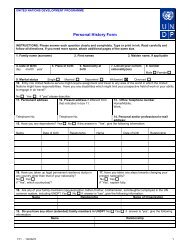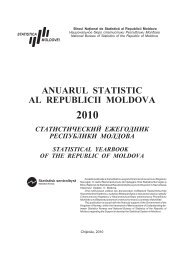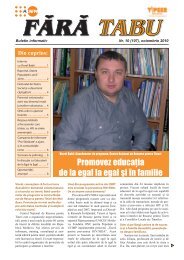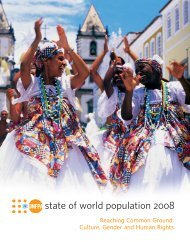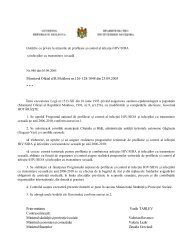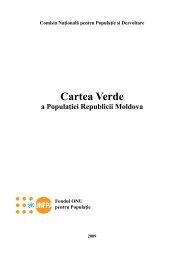Country Programme (2007-2011/2012) evaluation - UNFPA Moldova
Country Programme (2007-2011/2012) evaluation - UNFPA Moldova
Country Programme (2007-2011/2012) evaluation - UNFPA Moldova
Create successful ePaper yourself
Turn your PDF publications into a flip-book with our unique Google optimized e-Paper software.
health indicators related to programmes and activities supported by <strong>UNFPA</strong> show significant<br />
improvements compared to indicators in health areas not supported by the Fund. Similarly, the<br />
capacity building and policy advisory activities in P&D brought about important changes at the<br />
institutional and policy formulation level, although it is yet at its early stages of implementation.<br />
<strong>Programme</strong> and advocacy activities in the Gender, HRBA and gender equality GE component have<br />
helped to successfully implement normative and policy changes and to institutionalize HRBA and<br />
GE mainstreaming in policymaking and programme management. Here again, implementation is<br />
at its early stages. Work implemented in Transnistria deserves special attention, where positive<br />
results go far beyond technical and programme achievements in the RH component and achieve to<br />
create confidence building measures on the ground and with Transnistrian authorities, perfectly in<br />
line with governments strategy for reintegration of Transnistria. <strong>UNFPA</strong> carries the merit of being<br />
a pioneer in this field.<br />
Reproductive Health<br />
Activities implemented under the <strong>UNFPA</strong> CP contribute to development trends that are under multiple<br />
influences of government activities (policies and services), multi-donor activities and the participation<br />
(e.g. behavioural change) of the people themselves who benefit from these activities. All principle<br />
indicators for the RH sector show a positive trend and we can attribute that the implementation of the<br />
<strong>UNFPA</strong> CP (this is joint action of <strong>UNFPA</strong> and their implementing public and private partners)<br />
contributed to this trend. Some figures can give an impression about the general degree of change brought<br />
about in the RH sector.<br />
• The number of abortions(per year) dropped from 90,000 in the early 1990s to 14,000 (2008)<br />
• This trend continues since the number of abortions for every livenew-born child dropped from 0.7<br />
in 2000 to 0.4 in 2008<br />
• The maternal mortality rate from dropped from 27 in 2000 to 17 in 2009<br />
• The infant mortality rate dropped from 18 in 2000 to 12 in 2009<br />
• The under five mortality rate dropped from 23 in 2000 to 14 in 2009<br />
• The overall HIV incidence rate increasedfrom 4 in 2000 to 17 in 2009<br />
• The HIV incidence rate population between 15 to 24 increased from 10 in 2000 to 19 in 2009<br />
• National health costs/expenditure as share of GDPincreased from 3% in 2000 to 6% in 2009<br />
These indicators show a clear positive impact on reproductive health policies and the use of<br />
contraceptives but also show that there is still a lot of work to be done. HIV incidence increase for<br />
adolescent population is less than half of what it is for the overall population. Even if we cannot establish<br />
a causal link here in a scientific sense, the finding strongly suggests that peer-to-peer education has a<br />
positive effect. Figure 2 shows in a more specific example how the capacity building in RH service<br />
provision to vulnerable groups shows a positive impact, since HIV incidence among pregnant (screened)<br />
women decreases constantly for the first time ever. The first year of decrease was <strong>2007</strong>, coinciding with<br />
the <strong>UNFPA</strong> CP cycle initiation.<br />
<strong>UNFPA</strong> <strong>Moldova</strong> Extended <strong>Country</strong> <strong>Programme</strong> (<strong>2007</strong>-<strong>2011</strong>/12)<br />
Outcome Evaluation<br />
51


